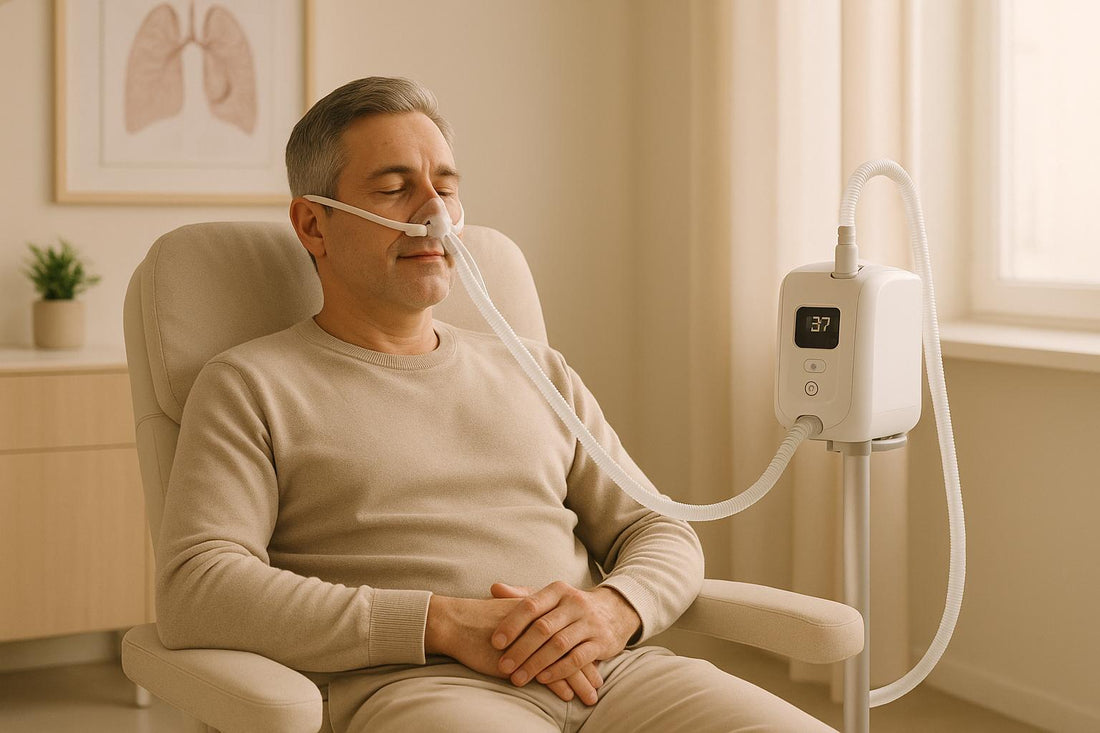
Nasal High-Flow for Chronic Respiratory Conditions
Share
Nasal High-Flow (NHF) therapy is a method of delivering heated, humidified oxygen to support people with chronic respiratory conditions like COPD and asthma. It solves common problems with older oxygen systems, such as dryness, discomfort, and inefficiency, by offering precise oxygen control and enhanced comfort. NHF can improve breathing, clear mucus, and reduce breathing effort, making it easier to manage long-term respiratory challenges.
Blocked nasal passages can reduce the therapy's effectiveness. BWLL Nasal Strips help by gently opening the nasal airways, ensuring better airflow and improving the overall impact of NHF. These strips are simple to use, hypoallergenic, and provide up to 18 hours of relief, making them a practical addition for Australians managing respiratory conditions.
How does Nasal High Flow work?
How Nasal High-Flow Therapy Works
Nasal High-Flow (NHF) therapy addresses the shortcomings of traditional oxygen treatments by offering a more effective way to deliver oxygen. It works by tailoring oxygen delivery to align with the body’s natural respiratory processes, improving both comfort and efficiency.
NHF Technology Features
NHF therapy relies on three key elements - heating, humidification, and high-flow delivery - to optimise oxygen for respiratory health. Unlike standard oxygen therapies, NHF warms the oxygen to body temperature (approximately 37°C) and saturates it with water vapour, achieving 100% relative humidity.
The heated humidification chamber ensures that the oxygen delivered is at the perfect temperature and moisture level. This prevents the dryness often associated with conventional oxygen treatments, which can irritate and damage the sensitive nasal lining, reducing the effectiveness of therapy.
Specially designed nasal cannulas allow for flow rates of up to 60 L/min. These cannulas are ergonomically crafted to ensure comfort during prolonged use while creating a reservoir effect in the nasopharynx. This design improves oxygen delivery efficiency without compromising patient comfort.
Another key feature is precise flow control, which enables clinicians to adjust oxygen concentration and flow rate independently. This flexibility allows for highly personalised treatment plans that can be adapted to each patient’s specific needs and changing health conditions.
Physical Benefits of NHF
NHF therapy offers a range of benefits that make breathing easier for patients with chronic respiratory conditions. The combination of controlled oxygen delivery and heated, humidified gas provides positive pressure, which helps open airways, thin mucus for easier clearance, flush out carbon dioxide, and recruit collapsed alveoli.
The high-flow delivery creates a mild positive airway pressure, helping to keep airways open and reducing the effort required to breathe. This is particularly helpful for people with conditions like COPD or bronchiectasis, where airway collapse is a common challenge.
One standout benefit is enhanced mucociliary clearance. The heated and humidified oxygen thins mucus, making it easier for the respiratory system to clear secretions naturally. This supports the body’s ability to maintain a clean and functional airway.
NHF therapy also facilitates dead space washout, where the high flow of oxygen effectively flushes carbon dioxide from the upper respiratory tract. This improves ventilation efficiency and reduces the effort needed for proper gas exchange.
Lastly, NHF therapy promotes better oxygenation through various mechanisms. The steady delivery of heated, humidified oxygen at precise concentrations ensures optimal oxygen uptake. Plus, the positive airway pressure helps reopen collapsed alveoli, improving overall lung function.
For many Australians, NHF therapy not only enhances clinical outcomes but also provides a level of comfort that makes longer treatment sessions more tolerable. This can lead to a noticeable improvement in quality of life for patients undergoing long-term respiratory care.
Clinical Evidence Supporting NHF Therapy
Recent studies suggest that nasal high-flow (NHF) therapy may help improve adherence to treatment for chronic respiratory conditions. While these findings are promising, further research is needed to solidify its benefits for Australians. These insights build on the technical and physiological benefits of NHF therapy discussed earlier.
Results in COPD and Bronchiectasis
In Australia, research focusing on COPD and bronchiectasis has shown some positive outcomes. These include reduced frequency of exacerbations, improved exercise tolerance, and better airway clearance. However, the availability of long-term data remains limited, leaving room for further investigation.
NHF vs Conventional Therapies
When compared to traditional oxygen delivery systems and non-invasive ventilation, NHF therapy has shown potential advantages in terms of comfort and mobility. Early comparative studies suggest that NHF could be a more patient-friendly option, but more evidence is needed to confirm these benefits and establish its place in standard care.
While the early results are encouraging, ongoing research will help determine the full potential of NHF therapy in respiratory care for Australians.
sbb-itb-dc10090
Improving NHF Therapy with Nasal Breathing Support
As mentioned earlier, the effectiveness of NHF therapy hinges on maintaining clear nasal airflow. By improving nasal airflow, therapy outcomes can be further enhanced. While NHF therapy is a promising option for managing chronic respiratory conditions, its success often depends on keeping nasal airways clear. When nasal passages are blocked, the therapy's efficiency can drop significantly. This poses a challenge for many Australians dealing with respiratory conditions, especially when nasal congestion arises due to environmental factors like allergens or dry air.
Blocked nasal passages can lead to mouth breathing, which bypasses the natural conditioning of air through the nose. This not only reduces comfort but also diminishes the overall effectiveness of NHF therapy. To combat this issue, additional solutions are needed to ensure clear nasal passages during therapy.
The Role of BWLL Nasal Strips

BWLL Nasal Strips offer a practical and effective way to support nasal breathing during NHF therapy. These hypoallergenic strips gently lift the nasal passages, widening the airways and allowing for better airflow and relief from nasal congestion. Designed for all-night comfort, each strip provides up to 18 hours of consistent support. The single-use design ensures optimal hygiene, making them a reliable choice for therapy sessions.
For those undergoing NHF therapy, BWLL Nasal Strips can play a key role in maintaining clear nasal airflow, helping to boost the therapy's overall impact. Crafted from high-quality materials, these strips are safe for daily use and suitable for a wide range of individuals, including pregnant women, ensuring they cater to the diverse needs of Australians facing respiratory challenges.
Benefits for Australians with Respiratory Challenges
Combining NHF therapy with nasal breathing support addresses multiple aspects of respiratory care. BWLL Nasal Strips deliver immediate relief from congestion without the need for medications, while also helping to reduce snoring and improve sleep quality - a critical benefit for those whose sleep is often disrupted by respiratory conditions.
These strips also support physical activity and fitness by enhancing oxygen intake during exercise, making them particularly useful for Australians managing chronic respiratory conditions while maintaining an active lifestyle. Additionally, BWLL’s commitment to eco-friendly packaging - using recycled and biodegradable materials - aligns with the values of environmentally conscious consumers. Priced at $36.00 for a pack of 30 strips, bulk purchase options provide added savings for regular users.
Thanks to their hypoallergenic design, BWLL Nasal Strips are gentle on sensitive skin, addressing a common concern for individuals with chronic respiratory conditions who may experience heightened sensitivity to adhesives. This makes them a practical and comfortable option for many Australians seeking effective nasal support.
Conclusion: Advancing Respiratory Care with NHF and BWLL
Nasal high-flow (NHF) therapy has brought a new level of care to Australians dealing with chronic respiratory conditions like COPD and bronchiectasis. By delivering heated, humidified oxygen at controlled flow rates, it tackles some of the common challenges of traditional oxygen therapies, such as dryness and discomfort, which often discourage consistent use.
Clinical studies highlight NHF therapy’s benefits, including reduced breathing effort, better gas exchange, and improved overall quality of life. However, maintaining clear nasal airways is crucial for its effectiveness, especially when dealing with environmental triggers or allergies.
To address nasal congestion - a key hurdle - BWLL Nasal Strips offer a simple yet effective solution. These hypoallergenic, single-use strips provide up to 18 hours of drug-free relief, making them a practical addition to NHF therapy. Priced at A$36.00 for a pack of 30, with bulk discounts available, they ensure optimal airflow and support treatment adherence.
FAQs
What makes Nasal High-Flow therapy more comfortable and effective than traditional oxygen therapies?
Nasal high-flow (NHF) therapy differs from traditional oxygen therapies by prioritising both comfort and efficiency. By delivering heated and humidified oxygen at higher flow rates, it helps maintain natural airway function and prevents nasal dryness, making it significantly more user-friendly.
On the effectiveness front, NHF offers several advantages. It enhances oxygenation, eases the effort required for breathing, and clears carbon dioxide more effectively. Additionally, it can provide mild positive airway pressure, offering extra respiratory support that standard methods like nasal cannulas or masks often lack. These features can contribute to quicker recovery times and may reduce the need for invasive interventions.
How can BWLL Nasal Strips support nasal high-flow therapy for chronic respiratory conditions?
Using BWLL Nasal Strips alongside nasal high-flow (NHF) therapy can make breathing easier by reducing nasal resistance and improving airflow. This combination keeps nasal passages open, supporting better oxygen intake and making NHF therapy more comfortable and effective.
BWLL Nasal Strips provide a drug-free, immediate solution to nasal congestion, perfectly complementing the benefits of NHF therapy. Together, they can lower the effort needed to breathe, enhance sleep quality, and promote overall respiratory health - an approach well-suited for managing chronic conditions in Australia.
What factors can influence the effectiveness of nasal high-flow therapy, and how can they be managed?
When it comes to the success of nasal high-flow (NHF) therapy, several factors come into play. These include age, gender, low ROX index, elevated heart rate, increased respiratory rate, and organ dysfunction scores. Since these factors can differ from person to person, they demand close and thoughtful consideration.
To improve outcomes, careful patient selection is key. Regular monitoring of respiratory metrics and making timely adjustments to flow rates can make a significant difference. Additionally, ensuring the nasal interface fits well and feels comfortable not only improves the therapy's effectiveness but also enhances the overall patient experience.